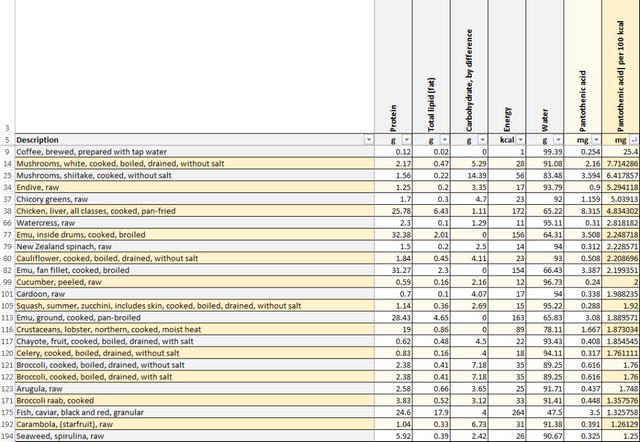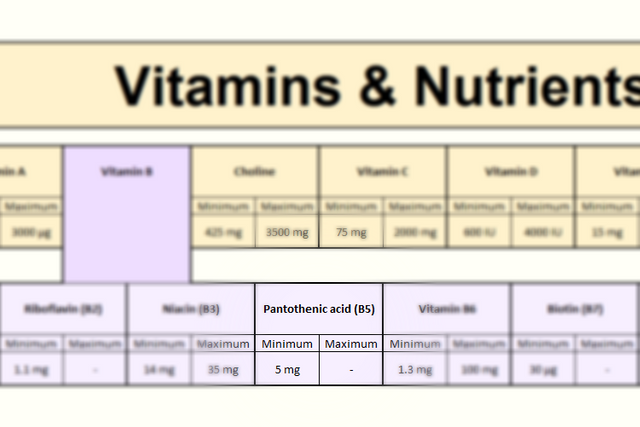Read the original, full, and up to date article here
Pantothenic Acid (Vitamin B5) is a water-soluble vitamin in the B series, essential for energy metabolism the biosynthesis of fatty acids and cholesterol, and is needed for normal function of the digestive system, skin, and nerves. Furthermore, Vitamin B5 is critical to the manufacture of red blood cells, as well as sex and stress-related hormones, and it helps with the absorption of other B vitamins, especially Riboflavin (B2).
Vitamin B5 supplements are sometimes recommended for stress relief, though further studies are needed to determine the effectiveness of such treatment.
Being water-soluble, it is stored in the liver and heart in small quantities, but excess amounts will be expelled quickly. This means we need an adequate, ongoing (daily) supply to keep B5 levels in the optimal range.
This article will cover the recommended intake levels, why we want to reach those levels, the dangers of overconsumption, and which foods are richest in Pantothenic Acid. As a twist, we sort foods by their nutrient to calorie ratios, as opposed to the more common per 100 gram values. This is because per calorie values correct for water content, and satiation.
Note that all recommended intake figures below are based on the needs of a 31 year old non-pregnant, non-lactating woman on a 2000 kilocalorie diet. Your personal requirements may differ (wildly). One way to figure out your individual needs, including calories per day, is the FooDosage Nutrition Calculator. It's free, by the way.
Recommended Pantothenic Acid Intake
The recommended intake range for Pantothenic Acid, as set by the National Academy of Sciences:
Recommended minimum intake (RDA): 5 mg per day
Upper limit: -
"No adverse effects associated with pantothenic acid from food or supplements have been reported. This does not mean that there is no potential for adverse effects resulting from high intakes. Because data on the adverse effects of pantothenic acid are limited, caution may be warranted."
In other words: Any amount of Vitamin B5 you can get from food sources is probably fine, but don't overdo it with supplements.
Note that your personal requirements may differ depending on your age, sex, pregnancy-, and lactation status.
Importance of an Adequate Pantothenic Acid Intake (Dangers of a Deficiency)
Vitamin B5 deficiencies are extremely rare, and are only really observed in victims of starvation and in volunteer trials. Data on the symptoms of a deficiency is therefore limited, but they may include:
- Fatigue
- Insomnia
- Depression
- Irritability
- Vomiting
- Stomach pains
- Burning feet
- Upper respiratory infections
Risks of an Excessive Pantothenic Acid Consumption (Side Effects)
As a water-soluble vitamin, excess Pantothenic Acid is usually expelled without complication. As opposed to fat soluble vitamins, liver toxicity is not a danger.
There is no evidence of adverse effects from the consumption of naturally occurring Vitamin B5 in foods, or otherwise. Though data on side effects from excess B5 intake from supplements is limited, so caution may be warranted.
Top 12 Pantothenic Acid (Vitamin B5) Food Sources
The highest concentrations of Pantothenic Acid are usually found in mushrooms, entrails such as livers or kidneys (especially poultry and beef), (game) meats, tomato products, yeast, egg yolk, some vegetables, and whole grains.
Some choice examples of Vitamin B5 rich foods:
 Pantothenic Acid Leaderboard – FooDosage Nutrition Calculator
Pantothenic Acid Leaderboard – FooDosage Nutrition Calculator
Note that for this ranking, the foods were sorted by their nutrient/calorie contents, as opposed to the more common nutrient/gram sorting method. This is because per calorie values correct for water content, and satiation. Example: Butter may contain more Vitamin A than Spinach per 100 grams, but eating the 120 grams of spinach necessary to reach the minimum recommended amount of Vitamin A is by far more feasible (and recommendable) than to eat the 100 grams of butter required for the same amount of Vitamin A..
.
.
Read the full Article on FooDosage.com
.
.
.
Bon Appetit :-)
Sources:
http://www.nationalacademies.org/hmd/Activities/Nutrition/SummaryDRIs/DRI-Tables.aspxhttp://www.umm.edu/health/medical/altmed/supplement/vitamin-b5-pantothenic-acid

Hi! I am a robot. I just upvoted you! I found similar content that readers might be interested in:
http://www.foodosage.com/pantothenic-acid-vitamin-b5-top-food-sources-rda-dangers-side-effects/
Downvoting a post can decrease pending rewards and make it less visible. Common reasons:
Submit